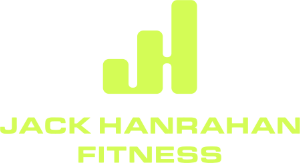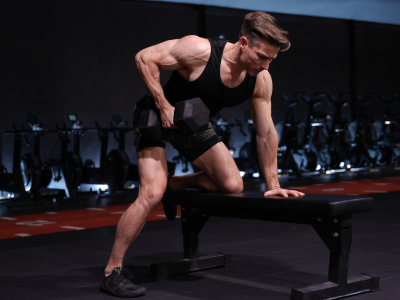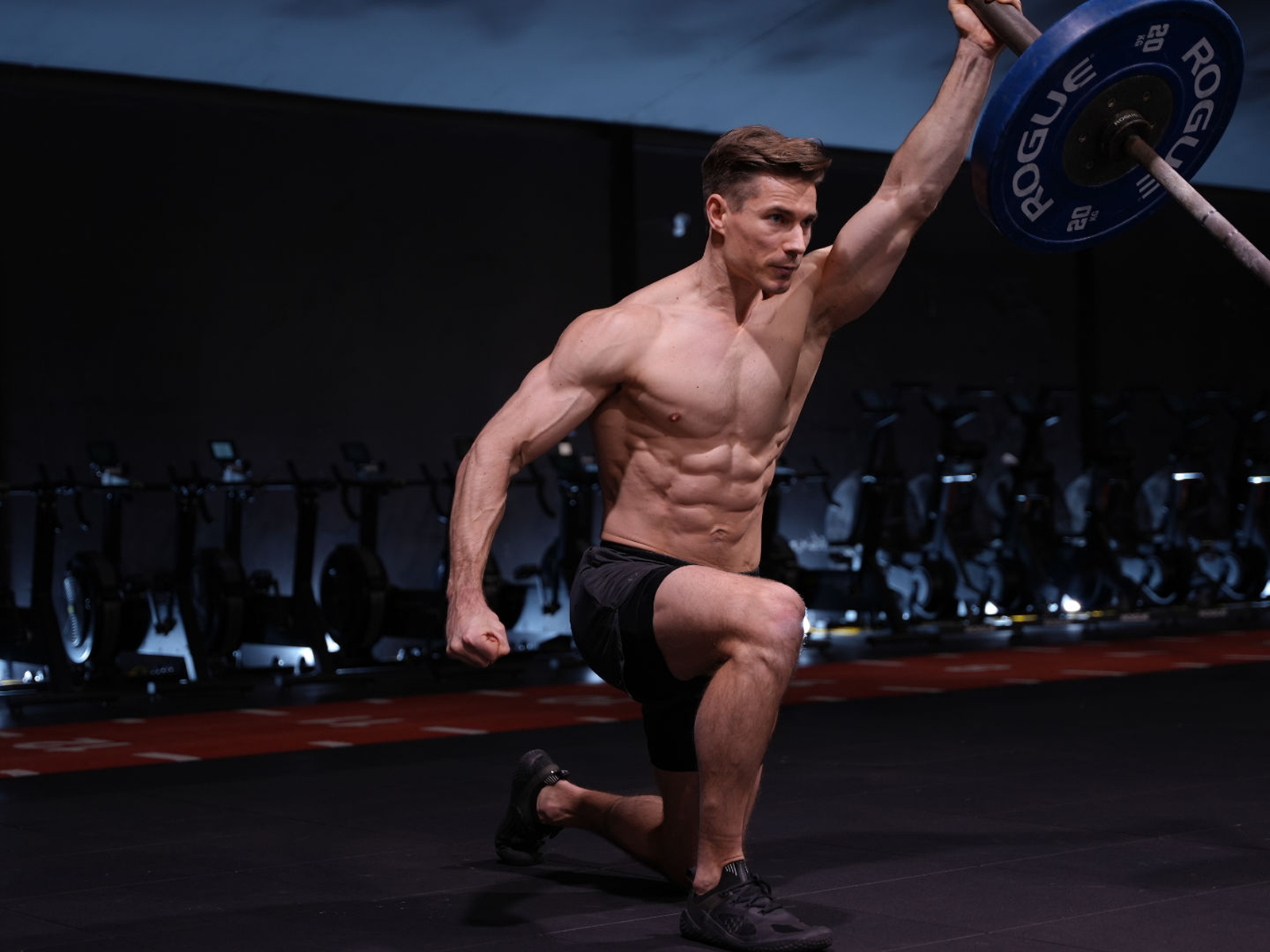Before you scroll down the page in search of that magic exercise – the ONE that’s standing between you and a curvaceous and powerful #peach, I want to take an entirely different approach.
You see, it’s not necessarily your exercise selection that is to blame. At least not initially. No matter what exercises you use or what your set and reps you use, your glutes aren’t going to grow unless you’re able to properly execute and activate.
My glutes are my most visibly well-developed muscle group (alas for my calves), and I’ve barely ever done popular glute builders like hip thrusts, frog pumps, or glute bridges.

I’m not genetically blessed and I’m certainly not spending hours a day training my butt with insane volume.
So: it’s not the exercises; it’s not the volume; it’s not genetic. It’s certainly not implants.
Once you rule those out, you’re left with a very, very short list of what’s absolutely necessary for impressive glute development.
In fact, aside from solid programming (which is essential to achieving any training goal), there’s only one item on that list.
MOVEMENT EXECUTION.
Watch anyone with a shapely posterior train and you can be sure of the following:
- They move well through the hips.
- They maintain a rigid spine by bracing the core – no butt wink and extreme low back arch in sight.
- They create tension and have established a really strong mind-muscle connection.
Yes, you can be darn sure that they’re also strong across a variety of squat and hip hinge pattern exercises: barbell squats, split squats, reverse lunges, barbell deadlifts, RDLs, and the like.
But all of those need to come with solid movement execution – so let’s go after that FIRST.
There are three things that can screw it up. And if you can avoid these three things, your glute progress will take off in no time.
#1 Poor Core Stability
To strongly activate the glutes – the core needs to do a good job of maintaining a rigid spine. Failure to do so and the low back will tend to round and arch all over the place when you’re training (You twerking or training bro?). This takes tension away from the glutes and instead aggravates the low back.
To understand this better – try this test out:
Core Bracing VS No Core Bracing
You should feel a very intense glute contraction when the spine is properly stabilized – this is because you’re maxing out hip extension (a function of the glutes) as opposed to low back hyperextension (NOT a function of the glutes). That excessive arch is death to the low back and stealing your glute gains.
So before anything else, the training goal is to strengthen the muscles that maintain a rigid spine to AVOID defaulting into that position.
ENTER- the Dead Bug.
The dead bug is the reigning king of core exercises and will teach you to maintain spinal stability.
Dead Bug Tutorial
Dead Bug Demo
This is how it’s done. Very slow and controlled. Core stability training is about execution and movement quality. Not just getting from A to B for a prescribed number of reps.
When you’ve mastered this, you’ll be better able to maintain that all important rigid spine, so you feel tension in all the right places. As your core strength improves, you can progress to more challenging ‘anti-extension’ core exercises such as plank progressions, ab wheel roll-outs, and hollow body holds.
#2 Poor Hip Mobility
If you don’t move well, you don’t stand a chance of building your glutes or any appreciable muscle mass. Think about it. Every exercise that you do has movement prerequisites. If you can’t get from A – B and back again without your form breaking down, then you shouldn’t be doing said exercise it. Makes sense right? But this point is very often ignored, which leads to one of two problems:
- You short change your range of motion and perform more of a half rep. For example – not fully extending the hip at the top of a barbell glute bridge because you lack hip extension.
- You perform the exercise anyway but your body compensates, borrowing ranges of motion from somewhere else. For example – rounding the back to get into a proper deadlift position.
Despite the injury risk, which goes without saying, both scenarios are problematic for glute gains. Without being able to express FULL range of motion at the hip – the gluteal tissues will not be able to shorten (concentric contraction) and lengthen (eccentric contraction) properly under tension. And this is not sufficient to stimulate muscle growth.
How to fix it?
WORK ON IT.
If you feel like your hips are stiff and don’t move well – devote more of your training time to improving it. The better your joints work – the better your movement execution will be.
Here are 4 of things you can do to help restore hip motion.
QUICK NOTE: For the stretches – 2 minutes is the minimum hold time to produce results.
Hip Flexion Stretch
Why?
The muscles at the front of the hip are very often tight. Blame all that sitting and desk-bound activity which shortens the tissues and limits their ability to express length – which consequently prevents the glutes from being able to shorten and contract properly.
90/90 Internal Rotation
Why?
Targets the joint capsule – the deepest layer of tissue. You can devote X amount of hours to stretching muscles that cross the hip but if you have capsular restrictions, your efforts are futile. Working on this can produce significant changes to your overall hip motion.
90/90 External Rotation
Why?
Targets deep muscles such as the external rotators and glute minimus, which connects directly to the joint capsule. It therefore influences muscle tissues AND the hip capsule. This stretch often works wonders to improve squat depth and technique.
Hip CARs
Why?
CARs are defined in geek speak as ‘active, rotational movements at the outer limits of articular motion’. In laymens terms, they are slow and controlled joint circles. This exercise is very effective at improving ACTIVE range of motion at the hip (Remember that stretching alone won’t produce results – we also need to include strengthening movements). Hip CARs activate all the hip muscles, stimulate the secretion of synovial fluid and improve neuromuscular control – to name just a few benefits. All in all, they provide tremendous bang for your buck from a mobility and joint health standpoint. I perform hip CARs daily upon waking and this is a staple movement in mine and my clients weight training warm ups (My Ebook ‘Warm up blueprint for weight training’ is dropping next week FYI)
#3 You haven’t mastered the ‘Hip Hinge’
A primary reason why a lot of people struggle to build their glutes is simply a lack of proficiency with this fundamental movement pattern.
To keep things simple – there are two fundamental lower body movement patterns:
- The Squat (Front squats, back squats, split squats, goblet squats etc etc)
- The Hip Hinge (conventional deadlifts, sumo deadlifts, RDL’s, hip thrusts etc)
Squat pattern exercises are deemed to be more quad dominant. Hip hinge pattern exercises are deemed to me more hip dominant (glutes / hams).
So then – it would make sense to ‘master the hip hinge’ right?
I thought so to.
Admittedly, hip hinging is a movement skill that takes some practice. Like anything else, practice makes you both more skilled and more efficient – which is what allows you to improve.
So I’m, going to lay out 3 of the best exercises to master it. From there, then you can go ahead and integrate the hinge more readily into your programming for better movement execution and – over time – much better results.
PRO TIP – Get strong with RDLs. This is far and away the best glute builder (there’s your magic exercise after all)
Wall Tap Hip Hinge
Why?
It teaches you to REACH back with the hips which is what loads the posterior chain. Think of hip hinging as more of a back and fourth movement of the hips as opposed to up and down (which defines a squat).
Dowell Hip Hinge
Why?
Teaches you to maintain a rigid spine and drive movement from the hips NOT the low back. You must maintain 3 points of contact – head, mid back and your tailbone. If the dowell lifts from your tailbone…you’re hinging at the low back which is not what we want. This a great tool for teaching proper hip hinging mechanics due to the kinaesthetic feedback of the dowell.
Pelvic Tilting
Why?
When you learn to control movement of the hips in isolation, you will be able to integrate that skill into more complex movements. This drill works on anterior and posterior ‘pelvic tilt’ which is a necessary component of proper hip hinge mechanics. The posterior tilt or ‘tucking’ of the tailbone will strongly activate the glutes. Practice this drill in 3 positions because as your body position changes in space, coordination will be thrown off . Master all 3 for a better transfer to any given glute exercise.
Wrapping Up
When you can confidently check off this list – you should find a strong transfer to better movement execution across any given glute exercise. Go get strong across a variety of exercises in both the low and high rep ranges, just like any other muscle group, and you’ll be busting out your lycra’s in no time 😉



You’re so good!!! Thank you for sharing your knowledge!
All your posts had help me a lot improving my training. I see all the time in my gym that no one stretches, warms up or do any of movements to get a better range of motion and in consequence most of them perform a really bad movement in their training.
I’ll be waiting for your next post so I can improve more over time.
Such a great help and info for all of us out here.
Greetings from Mexico
Thank you for such kind words. I appreciate the follow and very happy to help!
Great tips bro!
As someone that has weak glutes and poor hip mobility, how to you feel I should work these into my program? Should I just abandon my program and focus on these “non sexy” movements for now?
Really appreciate your content bro, keep it coming.
You can certainly still do the exercises in your program – but prioritize the stuff that’s going to improve your results long term. You already know the answer 😉
Super helpful and insightful! I’ve always had tight hips, but never really knew how to fix that. Definitely going to start incorporating these stretches!
Excellent, comprehensive post. I’ve received similar info from physical therapists, and this does a great job of explaining why and how.
Thanks.
This is awesome👌Thank you😎
I’m a chiropractor who deals with back pain or some sort of related issue. I fix the problem but not the habbit, so the problem comes back. Your posts have been very helpful to reinforce proper posture and movement patterns. I know it from personal experience.
Thank you so much and keep up the good work.
Ps. How do I subscribe to your newslater?
Thats awesome to hear. Thank you 🙂 Yes go to my website and there will be a sign up at the top or bottom of home page